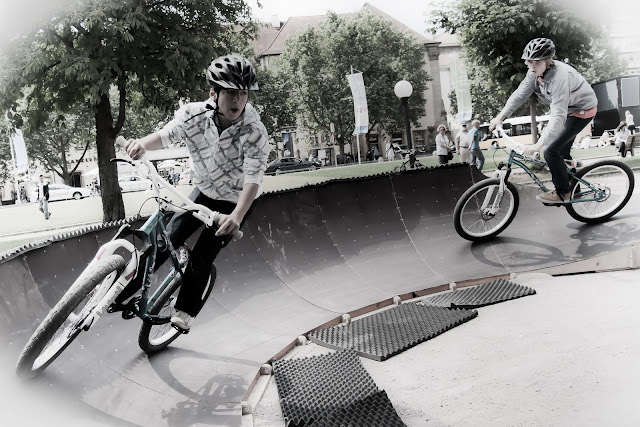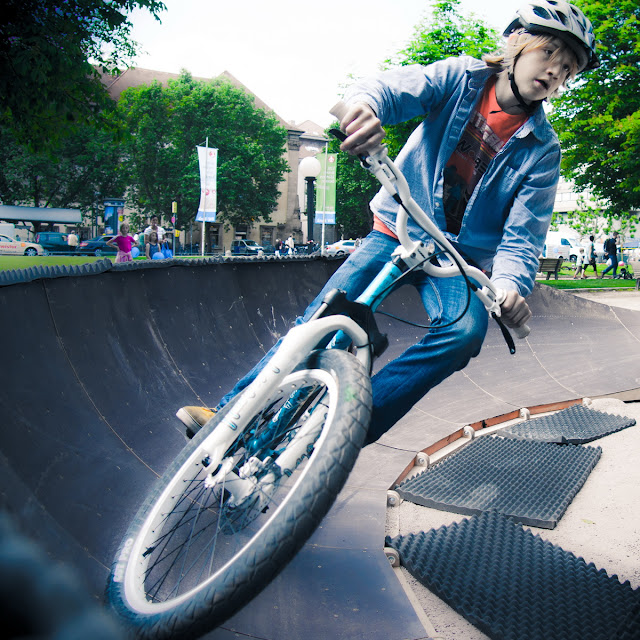Review of "Another Day with Jay Maisel"
If you missed this - and you probably did if you are here in Germany because the three-hour webcast started at midnight on June 6 - I want to try to summarize some of what was said so you can benefit from this master photographer's experience.
In a
post from last summer just before the Worldwide Photo Walk, I wrote down some tips garnered from
Scott Kelby's training video for street photography called "A Day with Jay Maisel": pack light, walk slowly, be prepared, look for the gesture, be open to new images, set your camera to guarantee you get the shot (high ISO and shutter speed), enjoy yourself and be friendly to those you meet (and may therefore want to photograph).
In this second video and webcast, the viewer goes away with even more of a sense of Jay's photographic frame of mind (pardon the pun). In addition, you got a sense of Scott Kelby's amiability, which at times borders on obsequiousness, though that is also part of the video's charm. Scott keeps coming back to the instructional purpose of the walk, putting easy-to-learn labels on what they are going after. It basically all boils down to gesture, light and color.
Equipment: Body and glass
 |
| 1/320 sec, f5.6, 400 ISO, 300mm |
Scott knew that the audience would be interested in their equipment, so he got those facts out on the table right away. During the webcast, a lot of people continued to ask what kind of camera and lens were in use. On the first walk, Jay and Scott had
Nikon D3s cameras with 70-300mm lenses. This time Jay has left the second lens home, the 24-70 he had in his belt pack, and is carrying only a 28-300. I asked in the webcast if the quality of that lens was good enough (I am not familiar with that Nikon lens but know that such super zooms are often less than stellar in quality). He answered, "If it wasn't, I wouldn't be using it." With that kind of range on your camera, you can go out open to whatever happens. Otherwise, I think you would normally say to yourself, "Today I'm feeling like shooting with a wide-angle lens [or a telephoto lens]."
Something else Jay always leaves at home is his
lens hood. At the onset of the first walk, he tried to convince Scott that it just made him look intimidating. Nevertheless, Scott had it on his lens (backwards) until Jay reminded him that he didn't need it.
A good day with Jay
 |
| 1/1000sec, f8, 400 ISO, 135mm |
|
As unspectacular as some of his pictures appeared to be, one got the sense that Jay goes out to have fun and doesn't like bowing to other people's rules. He shoots in
dappled light. He doesn't shoot a pick-up game of soccer because it wouldn't be fun spending an hour trying to get a good picture. Scott, on the other hand, seems to know and want to adhere to "the rules", such as using a lens hood to fight flare and add contrast to your pictures. On the other hand, one of the rules Jay handed out on the first walk was that you should keep shooting and not look at the display so much during your walk. But this time they were both spending a lot of time comparing shots and checking what they had just shot.
One of the great joys of watching Jay take pictures is seeing the child in him having fun. He admits that he keeps shooting because he enjoys seeing something he has never seen before: a certain light, a combination of colors, an interesting gesture.
Again and again, we see Jay following an important bit of his own advice: If someone allows you to take their picture, make the most of it. He walks through the streets, admittedly "looking like an idiot who is having a good time" and thinks people will be least suspicious of someone (acting) like that. Now and then he finds someone who stands there and lets him take her picture. He takes several and then says thank you.
Cropping: Making the most of the frame
 |
| 1/1000sec, f7.1, 800 ISO, 280mm |
|
Jay teaches his students to crop in the camera. "It's a discipline," he says. "If you say to yourself, 'I'll do it later,' then you get sloppy." He said in the first video that he doesn't like it when people take quick pictures without framing their subjects carefully. In this video he talks about "watching the corners", especially with a wide-angle lens (because there is so much more in the corners to watch). If you have distracting elements in the corners and edges, then the viewer won't be able to concentrate on the main motif. Plus, "The center is going to work out; that's what attracted me in the first place." At this point in his career, he says he tries harder to eliminate bad elements from his photographs than to put good elements in them. How many of us can claim to take pictures that way?
Jay doesn't like using the word "composition" (though he studied art and knows very well how important it is) but rather "framing" and "cropping". "The composition is already there," he says, underlining the improvisational aspect of his sort of street photography.
Exposures: Catching the action
 |
| 1/2000sec, f7.1, 800 ISO, 150mm |
Jay brackets while shooting, so he takes three pictures of everything, and he shoots RAW and JPEGs. With the D3s, a 12MP camera, that takes up a lot of memory. At one point in the first half of the video he "runs out of film" and has to put in a new memory card. The D3s has twin card slots, allowing you to record the same data on two cards simultaneously, or RAW on one and JPEG on the other (which is probably what Jay does), and transfer data from one card to another. So either he was using relatively small cards (8GB or smaller) or we didn't see but a fraction of the pictures he took that day.
He says his assistants post-process his shots to make them look like what he originally saw. He doesn't like to spend time in front of the computer; he'd rather be out shooting.
He shoots at ISO 1600 (on a sunny day!) and sets his aperture at f11-14 so that he can capture the shots he wants. Scott was using a lower ISO and realized that was reason his shots were not as sharp as Jay's. Jay seems to not listen to what people write about the physics of optics. Apparently, most lenses are sharpest two stops down from their maximum open aperture. He also doesn't care much about separating his main motif from the background (with a wide aperture) because at f14 everything is going to be sharp.
With the D3s there is practically no noise at 3200 and even 6400 is still acceptable. He admitted to having shot a concert at 12,800 ISO. For a full-frame 12.1 MP camera that goes up to the equivalent of ISO 102,400, what would you expect? In the meantime, I've been shooting with my Sony A700 increasingly at higher ISOs during the day and must admit to having caught some things that previously would have been too blurry.
He pointed out that most prize-winning pictures are "shitty technically" because that's not what counts. The gesture is more important than the technical side - "it's the picture not the pixels"!
Inspiration: Staying fresh
 |
| 1/1000sec, f6.3, 100 ISO, 17mm |
For inspiration, Jay suggests going to a good museum. Of course, looking at the works of masters of photography such as Henri Cartier-Bresson will both keep you humble and show you that great moments of truth can be captured with a camera if you are skilled and prepared. One of his favorite pictures is Arnold Newman's photograph of Igor Stravinsky at the piano. He's motivated by the possibility of seeing something he's never seen before. What keeps you going?
You get good at photography by putting in your time and doing a lot of hard work. Social networking will help you make money, but it won't make you good, says Jay.
If you want to have fun, stay open to what happens in front of your lens when you are out on the street. Jay says that to learn the craft he would send students out on three different walks, each time concentrating on one of these three aspects: gesture, light or color.
So now you have your assignment - get shooting (and have fun!).
P.S. On the Digital Photography School
website I saw a video of Leica photographer Eric Kim walking through the streets of L.A. snapping away. His style couldn't be more different from Jays. Check out the video
here. An in between approach can be seen in this
video about New York Leica photographer Jeff Mermelstein. I like what he says about his attitude toward his photography: "It's what I do. It's my way of responding to people." I think if we (amateur street) photographers were able to convince ourselves that we have a right to express ourselves through our artwork, then we would have fewer inhibitions about what we do.

























